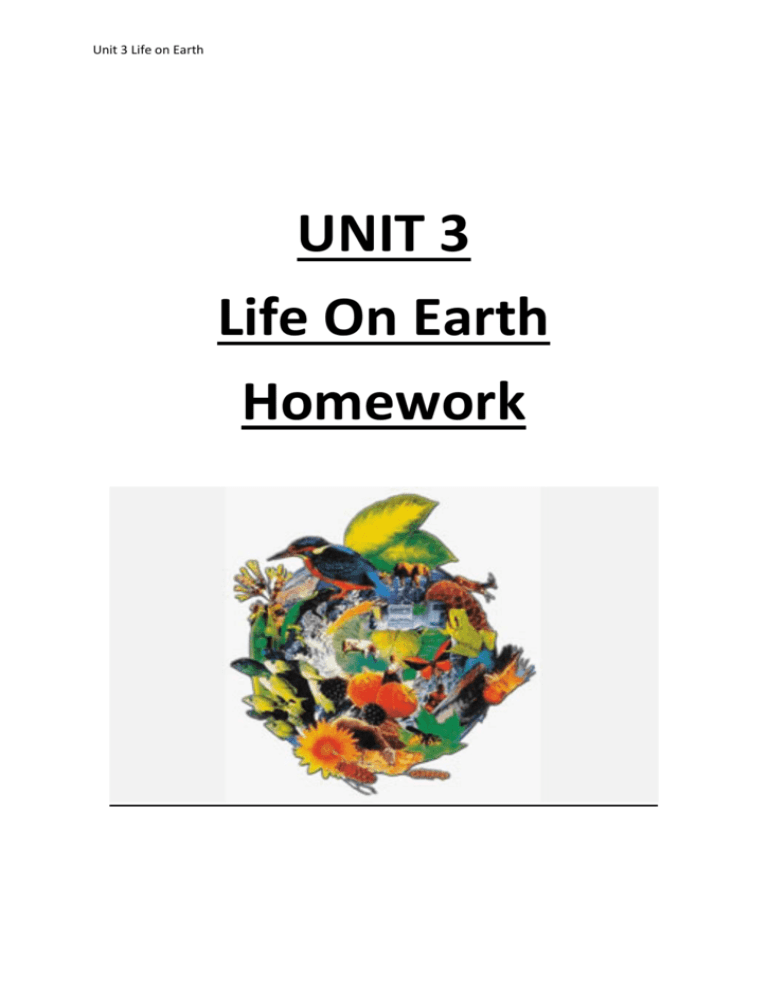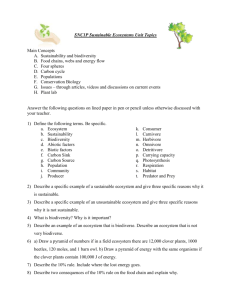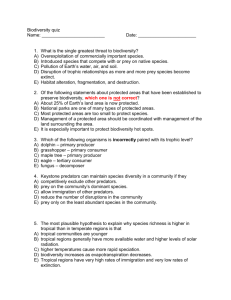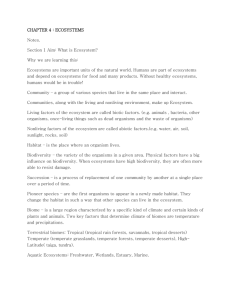Homework 2 Biotic factors and Biodiversity
advertisement

Unit 3 Life on Earth UNIT 3 Life On Earth Homework Unit 3 Life on Earth 1.Biodiversity and Distribution of life Homework 1 Ecosystems 1. 2. 3. 4. State what is meant by the term ‘ecosystem’. Explain why ecosystems require animals and plants State what is meant by the term ‘niche’. Give three examples of interactions organisms make with other organisms in their niche. 5. Give three examples of resources used by organisms in their niche. Homework 2 Biotic factors and Biodiversity 1. Give two biotic factors that may affect biodiversity in an ecosystem. 2. Explain how grazing affects biodiversity 3. The graph below shows the relationship between a predator and prey over a period of time. a) State the number of prey present at the beginning of the investigation. b) State the number of predators present at the beginning of the investigation. Unit 3 Life on Earth c) Describe the changes that occur in the number of prey over the tenweek investigation. d) Describe the changes that occur in the number of predators over the ten-week investigation. e) State when the highest number of prey are present. f) State when the highest number of predators are present. g) State the number of weeks it takes for the number of predators to reach its maximum after the number of prey reaches the maximum. h) Explain why there is a time delay before the number of predators reaches maximum value. i) Explain why the number of prey decreases from week 4. j) Explain why the number of predators decreases from week 6. k) Explain why the number of prey increase from week 9. l) Homework 3 Abiotic factors and Biodiversity 1. Give two abiotic factors that may affect biodiversity in an ecosystem. 2. Explain how pH can affect the variety of fish species in an ecosystem. 3. Explain how temperature can affect the variety of fish species in an ecosystem. Homework 4 Human influences and biodiversity 1. State two human activities that have resulted in habitat destruction. 2. Name two introduced species that have caused native species to become endangered 3. State what is meant by the term ‘pollution’. 4. The table shows some of the ways that humans influence biodiversity. Human influences that cause loss of biodiversity Over-hunting Over-fishing Competition from introduced species. Copy and complete the table above. Organisms that have been affected Unit 3 Life on Earth Homework 5 Biomes 1. State the term used to describe the different types of environment found on earth. 2. Name three different types of biome. 3. Explain what is meant by the terms ‘flora’ and ‘fauna’ 4. Explain how temperature influences the global distribution of biomes. 5. Explain how rainfall influences the global distribution of biomes. Unit 3 Life on Earth 2.Energy in ecosystems Homework 1 The role of organisms in food chains and webs a) b) c) d) State the source of energy in all ecosystems Explain what the arrows in food chains and webs show Suggest why all food chains begin with producers. Give 3 ways in which energy can be lost from a food chain Homework 2 Food chains and food webs The diagram below represents part of a food web constructed for a woodland ecosystem. Stoat Grey Squirrel Tawny Owl Wood Mouse Blue Tit Moth Caterpillar Oak Trees a) Insert on the diagram two further arrows to indicate that the blue tit is both a predator and prey. b) What is the source of energy entering this ecosystem? c) Most of the energy entering a food chain is lost rather than passed along that food chain. State two ways in which energy is lost from a food chain. Unit 3 Life on Earth Homework 3 Nutrient Cycle 1. Name the chemical element that plants and animals need to make protein. 2. Give the form of this chemical element that plants use to make protein. 3. State the role of decomposers in the nitrogen cycle. 4. Explain the role of nitrifying and denitrifying bacteria in the nitrogen cycle. 5. Explain the role root nodule bacteria play in the nitrogen cycle. Homework 4 Nutrient Cycle Nitrogen gas in the atmosphere G F Proteins in plants E A Proteins in animals B Nitrates in the soil Nitrites in the soil D 1. 2. 3. 4. 5. C Ammonium compounds in the soil Explain what is represented by arrow A. State which letter(s) represent death and decomposition. State which letter(s) represent the action of nitrifying bacteria. State which letter(s) represent the action of denitrifying bacteria. State which letter(s) represent the action of nitrogen fixing bacteria. B Unit 3 Life on Earth 6. State where nitrogen-fixing bacteria are found. 7. Explain why nitrogen cycling is important in ecosystems. Unit 3 Life on Earth 3.Sampling techniques 1. In the grass bank represented in the diagram below, biologists discovered a species of poppy and wanted to estimate the abundance of this species in the whole bank. To do this they used a quadrat of area 1m as shown in the diagram. X = one poppy plant a) Copy and complete the table below to show the information collected about the abundance of poppies in the grass bank. Quadrat Number of poppies found in quadrat 1 2 3 4 5 b) Calculate the: I. Average abundance per quadrat (1m) II. Area of grass bank III. Estimated abundance of poppies in the grass bank c) I. What is the actual number of poppies in the grass bank? II. 6 Unit 3 Life on Earth 4. Adaptation, Natural Selection and the evolution of species Homework 1 Adaptations for survival 1. State what is meant by the term ‘adaptation’. 2. State what is meant by a behavioural response 3. Give two examples of animals that respond to environmental stimuli. Adaptations of desert mammals 1. Explain why organisms living in deserts need to be adapted to survive 2. Give one behaviour adaptation and one structural adaptation of the desert rat that help it survive in the desert. Adaptations in plants 1. The diameter of a barrel cactus was measured before and after rainfall. The measurement was found to be: 32 cm before the fain fell 44cm after rainfall. a) State the percentage increase in the diameter of cactus after rainfall. b) Suggest an adaptation that this type of cactus has to allow it to increase in diameter c) The leaves of these cacti are reduced to spines to reduce water loss. Suggest another advantage of having spines instead of leaves. Homework 2 Mutations 1. Give the definition of the term ‘mutation’ 2. Give three possible side effects on an organism that a mutation may have. 3. State two environmental factors that could increase the rate of mutations. 4. Give the term that is used to describe environmental factors that bring about mutations. 5. Mutations can be caused by being exposed to radiation and from chemicals. A study was carried out into the sources of radiation and how much each source contributed to the total exposure. Unit 3 Life on Earth It was found that natural radioactivity in the air accounted for 38% of the total radiation. The ground and buildings exposed people to exactly half of the natural radioactivity in the air. Surprisingly 16% of the radiation came from food and drink. Medical X-rays accounted for 13%. Cosmic rays from space accounted for 1% more than medical X-rays. a) Present the information given above as a table b) State the percentage contribution that comes from natural radioactivity and medical X-rays. Homework 3 Natural Selection 1. State why organisms produce more offspring than the environment can sustain. 2. State what members of a population survive to reproduce 3. Give two resources that organisms struggle to obtain Homework 4 Speciation 1. Explain what is meant by the term ‘species’ 2. Give the term that is used to describe the process that allows a new species to develop. 3. Explain why isolation is needed in the formation of a new species 4. Explain why natural selection is needed in the formation of a new species Unit 3 Life on Earth 5.Human impact on the environment Homework 1 Increasing human population 1. State why the human population needs to increase the production of food. 2. Explain why intensive farming is used to produce food. 3. Explain why intensive farming animals are prevented from moving freely. 4. Give three disadvantages of monocultures. 5. Explain why there is a high use of fertilisers in monocultures. Homework 2 Fertilisers 1. Give a reason why farmers spray fertilisers onto their crops. 2. Explain how an algal bloom may be caused in fresh water. 3. Explain why oxygen levels in water may be reduced by an algal bloom. Homework 3 Indicator Species 1. 2. 3. 4. Explain what is meant by the term pollution Give three examples of ecosystems that can be harmed by pollution Describe what is meant by the term indicator species Predict the level of pollution and oxygen concentration in a river if mayfly larvae are found. Homework 4 Biological control 1. State why farmers use biological control in farming 2. Explain how biological control can reduce the use of chemicals in farming 3. Give three advantages of using biological control rather than pesticides 4. Give three disadvantages of using biological control rather than pesticides









